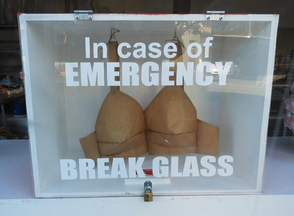
Predictors of Three-Dimensional Breast Kinematics during Bare-Breasted Running has been published in Medicine and Science in Sports and Exercise. The study “aimed to analyse differences in breast kinematics between breast cup sizes during running and the ability of breast and body size measurements to explain these differences.”
The hope is that this data and knowledge will inform those who make bras, enabling them to design and manufacture more supportive bras. Or supportive bras.
The question is: will it? This latest study follows earlier findings in a 2010 study involving a few members of this most recent study The effect of breast support on the kinematics of the breast during the running gait cycle. This earlier study found: “The magnitude and trajectory of breast acceleration was unaffected by increasing breast support and showed no correlation with comfort.” The 2010 team suggested further studies and that three-dimensional analysis could be beneficial to bra design.
In 2008 the same people at the University of Portsmouth were pinging bra straps and publicising their findings about ill fitting brassieres. Why, you might ask, are scientists spending time measuring breast displacement and giving the bra industry tips?
I don't think anybody is more undecided about breasts than women. Where The Sun newspaper has a healthy appreciation for BOOBS, and medical pamphlets inform you to check your BREASTS, and your gay best friend is amused by your TITTIES (it was funny at the time) women don't seem to be curious about a well fitting bra for their...their chest business.
Now, there are some who would refuse to bother about this. Breasts are not intended by nature to be photographed for The Sun as they impart their opinion on current affairs. Breasts are designed to feed babies and their ability to do so is not changed whether they are saggy or reaching for the skies. Fair dos. Age, gravity and possibly child-bearing all have a rather dragging effect on the noble bosom. Nipples, they say, have been waving to the daisies for millions of years. Meaning it need not be corrected.
But eye sight fails, bones start to crumble and muscles seize up. Do we ignore those things because it's just nature's way? No, we address them because it makes getting around easier. Support from a bra helps some women get around easier.
For those who have breasts that tend towards the pendulous a bra that provided true support would not be a slap in the saggy tit to our topless ancestors.
Quite frankly it seems Wood, White, Milligan, Ayres, Hedger and Scurr are on to the majority of the bra wearing public. Wendy Hedger told the BBC in 2008 that: "There's a social stigma about certain sizes. Many women don't want to be seen as too small or too big and buy a bra that doesn't fit well in order to be what they consider to be a normal size.”
Of course some of this social stigma could be alleviated by a redesign of larger sizes. I would like to propose a new study for the University of Portsmouth and University of Gloucester to tackle. What is going through the minds of bra manufacturers when they design all bras above a D cup to finish just below the chin. Does cleavage require such caging? Is the décolletage something that must be swathed in material?
The larger bra looks suspiciously like it was designed purely for the amusement of browsers so dedicated to comedy that they would put an FF cup on their head (it never fails). So is it any wonder women aren't much better informed than those husbands and boyfriends sent to negotiate the M&S lingerie department, forced to make hand cupping gestures to guess their partner's bra size?
Casting an eye over the Bravissimo which is dedicated to making larger bras to see design still has a long way to go. Therefore we at Squeamish Bikini applaud both the people behind the study and the 48 women ran, braless, on a treadmill. We share a dream of comfortable, supportive bras...
Squeamish Kate

 RSS Feed
RSS Feed
